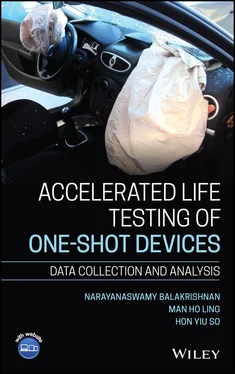In addition, the inferential methods and the procedures for planning accelerated life‐tests discussed in this book are not only limited to one‐shot devices alone but also can be extended naturally to accelerated life‐tests with periodic inspections (interval‐censoring) and those with continuous monitoring and censoring (right‐censoring). The book finally concludes by highlighting some important issues and problems that are worth considering for further research. This may be especially useful for research scholars and new researchers interested in taking on this interesting and challenging area of research in reliability theory and practice.
It is possible that some pertinent results or references got omitted in this book, and we assure you that it is due to inadvertency on our part and not due to scientific antipathy. We will appreciate greatly if the readers inform us of any corrections/omissions, or any comments pertinent to any of the discussions in the book!
Our sincere thanks go to the entire Wiley team, Ms. Mindy Okura‐Marszycki, Ms. Kathleen Santoloci, and Mr. Brett Kurzman, for taking great interest in this project from day one, for all their help and encouragement during the whole course, and for their fine assistance during the final production stage of the book. Our thanks also go to our research collaborators and graduate students for their incisive comments and queries, which always benefited us greatly and helped clarify some of our own ideas! We express our sincere appreciation to Ms. Elena Maria Castilla Gonzalez, a doctoral student of Professor Leandro Pardo in the Department of Statistics and Operations Research at Complutense University of Madrid, Spain, for her careful reading of Chapter 5 and also for sharing with us some R codes that she had developed concerning robust inferential methods for one‐shot device test analyses. Last but not least, our special thanks go to our families for their patience and understanding, and for providing constant support and encouragement during our work on this book!
Finally, the first author (NB) wishes to state to his older daughter, Ms. Sarah Balakrishnan, that though she lost out on getting his Volvo car due to a major car accident, she should be heartened by the fact that the accident resulted in the germination of his interest and ideas on one‐shot devices (airbags), and ultimately this book solely dedicated to the topic!
July, 2020
Narayanaswamy Balakrishnan
Man Ho Ling
Hon Yiu So
About the Companion Website
This book is accompanied by a companion website:

www.wiley.com/go/Balakrishnan/Accelerated_Life_Testing
The Student companion site will contain the codes and case studies.
1 One‐Shot Device Testing Data
1.1 Brief Overview
One‐shot device testing data analyses have recently received great attention in reliability studies. The aim of this chapter is to provide an overview on one‐shot device testing data collected from accelerated life‐tests (ALTs). Section 1.2surveys typical examples of one‐shot devices and associated tests in practical situations. Section 1.3describes several popular ALTs, while Section 1.4provides some examples of one‐shot device testing data that are typically encountered in reliability and survival studies. Finally, Section 1.5details some recent developments on one‐shot device testing data analyses and associated issues of interest.
Valis et al. (2008) defined one‐shot devices as units that are accompanied by an irreversible chemical reaction or physical destruction and could no longer function properly after its use. Many military weapons are examples of one‐shot devices. For instance, the mission of an automatic weapon gets completed successfully only if it could fire all the rounds placed in a magazine or in ammunition feed belt without any external intervention. Such devices will usually get destroyed during usual operating conditions and can therefore perform their intended function only once.
Shaked and Singpurwalla (1990) discussed the submarine pressure hull damage problem from a Bayesian perspective and assessed the effect of various strengths of underwater shock waves caused by either a nuclear device or a chemical device on the probability of damage to a submarine pressure hull. A record is made of whether a copy of a diminutive model of a submarine pressure hull is damaged or not, and a specific strength of the shock wave on the model. Fan et al. (2009) considered electro‐explosive devices in military applications, which induct a current to excite inner powder and make them explode. Naturally, we cannot adjudge the functioning condition of the electro‐explosive device from its exterior, but can only observe it by detonating it directly. After a successful detonation, the device cannot be used anymore; if the detonation becomes a failure, we will also not know when exactly it failed. Nelson (2003) described a study of crack initiation for turbine wheels. Each of the 432 wheels was inspected once to determine whether it had started to crack or not. Newby (2008) provided some other examples of one‐shot devices, such as fire extinguishers or munitions. A full test would require the use of the considered devices and, therefore, their subsequent destruction. The test carried out would show whether a device is still in a satisfactory state, or has failed by that inspection time.
One‐shot device testing data also arise in destructive inspection procedures, wherein each device is allowed for only a single inspection because the test itself results in its destruction. Morris (1987) presented a study of 52 Li/SO  storage batteries under destructive discharge. Each battery was tested at one of three inspection times and then classified as acceptable or unacceptable according to a critical capacity value.
storage batteries under destructive discharge. Each battery was tested at one of three inspection times and then classified as acceptable or unacceptable according to a critical capacity value.
Ideally, reliability data would contain actual failure times of all devices placed on test (assuming, of course, the experimenter could wait until all devices fail), so that the observed failure times can reveal the failure pattern over time, and we could then estimate the reliability of the device reasonably. But, in practice, many life‐tests would get terminated before all the units fail. Such an early stoppage of the life‐test by the experimenter may be due to cost or time constraints or both. This would result in what is called as “right‐censored data” because the exact failure times of the unfailed devices are unknown, but all we know is that the failure times of those devices are larger than the termination time. Considerable literature exists on statistical inference for reliability data under right‐censoring; for example one may refer to the books by Cohen (1991), Balakrishnan and Cohen (1991), and Nelson (2003).
Moreover, when nondestructive and periodic inspections are carried on devices, their exact failure times will not be observed, but the intervals wherein the failures occurred will only be available. If a failure is observed by the first inspection, then it is known that the failure time of the device is less than the first inspection time, resulting in “left‐censoring.” Similarly, if a failure is observed between two consecutive inspection times, then it is known that the failure time is between these two corresponding inspection times, resulting in “interval‐censoring.” Finally, the failure times of all surviving units at the final inspection time are right‐censored as their exact failure times will not be observed. Exact failure times can only be observed from a life‐testing experiment with continuous surveillance. The periodic inspection process with nondestructive evaluation would actually provide a reasonable approximation to failure times of devices under test, especially when the inspection time intervals are short, even though the precision of inference will be less in this case.
Читать дальше


 storage batteries under destructive discharge. Each battery was tested at one of three inspection times and then classified as acceptable or unacceptable according to a critical capacity value.
storage batteries under destructive discharge. Each battery was tested at one of three inspection times and then classified as acceptable or unacceptable according to a critical capacity value.










